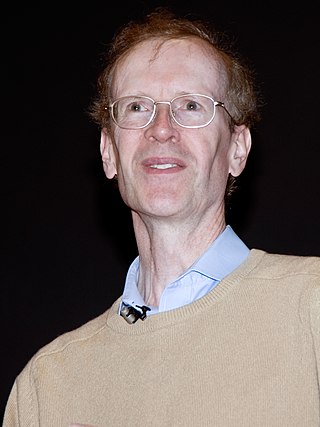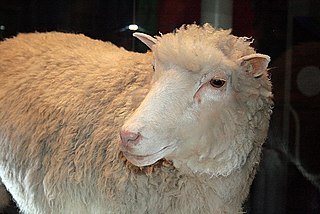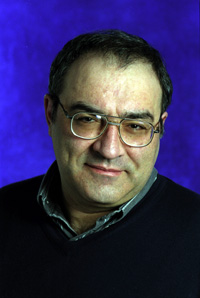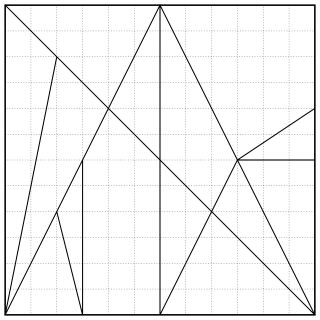
Sir Andrew John Wiles is an English mathematician and a Royal Society Research Professor at the University of Oxford, specialising in number theory. He is best known for proving Fermat's Last Theorem, for which he was awarded the 2016 Abel Prize and the 2017 Copley Medal and for which he was appointed a Knight Commander of the Order of the British Empire in 2000. In 2018, Wiles was appointed the first Regius Professor of Mathematics at Oxford. Wiles is also a 1997 MacArthur Fellow.

Dolly was a female Finn-Dorset sheep and the first mammal that was cloned from an adult somatic cell. She was cloned by associates of the Roslin Institute in Scotland, using the process of nuclear transfer from a cell taken from a mammary gland. Her cloning proved that a cloned organism could be produced from a mature cell from a specific body part. Contrary to popular belief, she was not the first animal to be cloned.

Grace Brewster Hopper was an American computer scientist, mathematician, and United States Navy rear admiral. She was a pioneer of computer programming. Hopper was the first to devise the theory of machine-independent programming languages, and used this theory to develop the FLOW-MATIC programming language and COBOL, an early high-level programming language still in use today. She was also one of the first programmers on the Harvard Mark I computer. She is credited with writing the first computer manual, "A Manual of Operation for the Automatic Sequence Controlled Calculator."

Judith Beatrice Bari was an American environmentalist, feminist, and labor leader, primarily active in Northern California after moving to the state in the mid-1970s. In the 1980s and 1990s, she was the principal organizer of Earth First! campaigns against logging in the ancient redwood forests of Mendocino County and related areas. She also organized Industrial Workers of the World Local 1 in an effort to bring together timber workers and environmentalists of Earth First! in common cause.

Dame Judith Olivia Dench is an English retired actress. Widely considered one of Britain's greatest actors, she is noted for her versatile work in various films and television programmes encompassing several genres , as well as for her numerous roles on the stage. Dench has garnered various accolades throughout a career that spanned seven decades, including an Academy Award, a Tony Award, two Golden Globe Awards, four British Academy Television Awards, six British Academy Film Awards, and seven Olivier Awards.

Leonid Genrikhovich Khachiyan was a Soviet and American mathematician and computer scientist.

The Isaac Newton Institute for Mathematical Sciences is an international research institute for mathematics and its many applications at the University of Cambridge. It is named after one of the university's most illustrious figures, the mathematician and natural philosopher Sir Isaac Newton, and occupies one of the buildings in the Cambridge Centre for Mathematical Sciences.

Marshall Harvey Stone was an American mathematician who contributed to real analysis, functional analysis, topology and the study of Boolean algebras.

Herman Heine Goldstine was a mathematician and computer scientist, who worked as the director of the IAS machine at the Institute for Advanced Study and helped to develop ENIAC, the first of the modern electronic digital computers. He subsequently worked for many years at IBM as an IBM Fellow, the company's most prestigious technical position.

Cathleen Synge Morawetz was a Canadian mathematician who spent much of her career in the United States. Morawetz's research was mainly in the study of the partial differential equations governing fluid flow, particularly those of mixed type occurring in transonic flow. She was professor emerita at the Courant Institute of Mathematical Sciences at the New York University, where she had also served as director from 1984 to 1988. She was president of the American Mathematical Society from 1995 to 1996. She was awarded the National Medal of Science in 1998.
Graffiti is a computer program which makes conjectures in various subfields of mathematics and chemistry, but can be adapted to other fields. It was written by Siemion Fajtlowicz and Ermelinda DeLaViña at the University of Houston. Research on conjectures produced by Graffiti has led to over 60 publications by other mathematicians.

Nina Karlovna Bari was a Soviet mathematician known for her work on trigonometric series. She is also well-known for two textbooks, Higher Algebra and The Theory of Series.

Ruth Aaronson Bari was an American mathematician known for her work in graph theory and algebraic homomorphisms. She was a professor at George Washington University, beginning in 1966.

James Alan Shapiro is an American biologist, an expert in bacterial genetics and a professor in the Department of Biochemistry and Molecular Biology at the University of Chicago.
Siemion Fajtlowicz is a Polish-American mathematician, formerly a professor at the University of Houston. He is known for creating and developing the conjecture-making computer program Graffiti.

In ancient Greek geometry, the Ostomachion, also known as loculus Archimedius or syntomachion, is a mathematical treatise attributed to Archimedes. This work has survived fragmentarily in an Arabic version and a copy, the Archimedes Palimpsest, of the original ancient Greek text made in Byzantine times.

Abigail A. Thompson is an American mathematician. She works as a professor of mathematics at the University of California, Davis, where she specializes in knot theory and low-dimensional topology.

Eugenia Loh-Gene Cheng is a British mathematician, educator and concert pianist. Her mathematical interests include higher category theory, and as a pianist she specialises in lieder and art song. She is also known for explaining mathematics to non-mathematicians to combat math phobia, often using analogies with food and baking. Cheng is a scientist-in-residence at the School of the Art Institute of Chicago.

The 20th century saw multiple trends and changes in women's fitness culture.
Antisemitism in Soviet mathematics was a manifestation of hostility, prejudice and discrimination in the Soviet Union towards Jews in the scientific and educational environment related to mathematics.
















